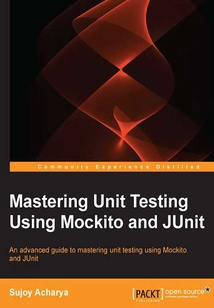首頁(yè) > 計(jì)算機(jī)網(wǎng)絡(luò) >
數(shù)據(jù)庫(kù)
> Mastering Unit Testing Using Mockito and JUnit最新章節(jié)目錄
舉報(bào) 

會(huì)員
Mastering Unit Testing Using Mockito and JUnit
最新章節(jié):
Index
Apracticalandeasy-to-follow,yetcomprehensive,guidetolearningadvancedJUnittesting.Eachtopicisexplainedandplacedincontext,andforthemoreinquisitive,therearemoredetailsoftheconceptsused.ThisbookisforyouifyouareadeveloperwithsomeexperienceinJavaapplicationdevelopmentaswellasabasicknowledgeofJUnittesting.ButforthosewhoseskillsetisvoidofanypriorexperiencewithJUnittesting,thebookalsocoversbasicfundamentalstogetyouacquaintedwiththeconceptsbeforeputtingthemintopractise.
目錄(74章)
倒序
- 封面
- 版權(quán)頁(yè)
- Credits
- About the Author
- About the Reviewers
- www.PacktPub.com
- Support files eBooks discount offers and more
- Preface
- What this book covers
- What you need for this book
- Who this book is for
- Conventions
- Reader feedback
- Customer support
- Chapter 1. JUnit 4 – a Total Recall
- Defining unit testing
- Working with JUnit 4
- Working with JUnit 4++
- Summary
- Chapter 2. Automating JUnit Tests
- Continuous Integration
- Jenkins
- Summary
- Chapter 3. Test Doubles
- Dummy
- Stub
- Fake
- Mock
- Spy
- Summary
- Chapter 4. Progressive Mockito
- Working with Mockito
- Drinking Mockito
- Summary
- Chapter 5. Exploring Code Coverage
- Understanding code coverage
- Configuring the Eclipse plugin
- Measuring coverage using Gradle
- Working with the Maven Cobertura plugin
- Running the Cobertura Ant task
- Summary
- Chapter 6. Revealing Code Quality
- Understanding the static code analysis
- Working with the Checkstyle plugin
- Exploring the FindBugs plugin
- Working with the PMD plugin
- Monitoring code quality with SonarQube
- Getting familiar with false positives
- Summary
- Chapter 7. Unit Testing the Web Tier
- Unit testing servlets
- Playing with Spring MVC
- Summary
- Chapter 8. Playing with Data
- Separating concerns
- Unit testing the persistence logic
- Simplifying persistence with Spring
- Verifying the system integrity
- Writing integration tests with Spring
- Summary
- Chapter 9. Solving Test Puzzles
- Working with the legacy code
- Designing for testability
- Working with greenfield code
- Summary
- Chapter 10. Best Practices
- Writing meaningful tests
- Automating JUnit tests
- Configuring tests
- Working with assertions
- Handling exceptions
- Working with test smells
- Summary
- Index 更新時(shí)間:2021-12-08 12:38:51
推薦閱讀
- Spark快速大數(shù)據(jù)分析(第2版)
- Learning JavaScriptMVC
- Neural Network Programming with TensorFlow
- 數(shù)據(jù)驅(qū)動(dòng)設(shè)計(jì):A/B測(cè)試提升用戶(hù)體驗(yàn)
- 數(shù)據(jù)革命:大數(shù)據(jù)價(jià)值實(shí)現(xiàn)方法、技術(shù)與案例
- Starling Game Development Essentials
- 數(shù)據(jù)挖掘原理與SPSS Clementine應(yīng)用寶典
- 智能數(shù)據(jù)時(shí)代:企業(yè)大數(shù)據(jù)戰(zhàn)略與實(shí)戰(zhàn)
- “互聯(lián)網(wǎng)+”時(shí)代立體化計(jì)算機(jī)組
- 數(shù)據(jù)庫(kù)設(shè)計(jì)與應(yīng)用(SQL Server 2014)(第二版)
- 聯(lián)動(dòng)Oracle:設(shè)計(jì)思想、架構(gòu)實(shí)現(xiàn)與AWR報(bào)告
- Oracle高性能SQL引擎剖析:SQL優(yōu)化與調(diào)優(yōu)機(jī)制詳解
- Access數(shù)據(jù)庫(kù)開(kāi)發(fā)從入門(mén)到精通
- Mastering ROS for Robotics Programming(Second Edition)
- 中國(guó)云存儲(chǔ)發(fā)展報(bào)告
- AndEngine for Android Game Development Cookbook
- 云原生架構(gòu):從技術(shù)演進(jìn)到最佳實(shí)踐
- 大數(shù)據(jù)技術(shù)體系詳解:原理、架構(gòu)與實(shí)踐
- 數(shù)據(jù)可視化五部曲
- Reactive Programming in Kotlin
- 實(shí)用推薦系統(tǒng)
- Flink與Kylin深度實(shí)踐
- 數(shù)據(jù)分析師手記:數(shù)據(jù)分析72個(gè)核心問(wèn)題精解
- Access 2010數(shù)據(jù)庫(kù)程序設(shè)計(jì)
- MySQL數(shù)據(jù)庫(kù)項(xiàng)目化教程
- 大數(shù)據(jù)搜索引擎原理分析
- 數(shù)據(jù)庫(kù)系統(tǒng)管理應(yīng)用
- 數(shù)據(jù)可視化分析:Tableau原理與實(shí)踐(全彩)
- 大數(shù)據(jù)征信及智能評(píng)估:征信大數(shù)據(jù)挖掘與智能分析技術(shù)
- 軌跡數(shù)據(jù)分析方法及應(yīng)用

